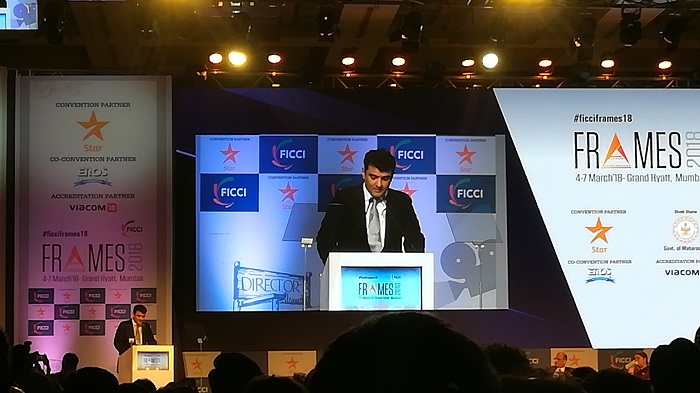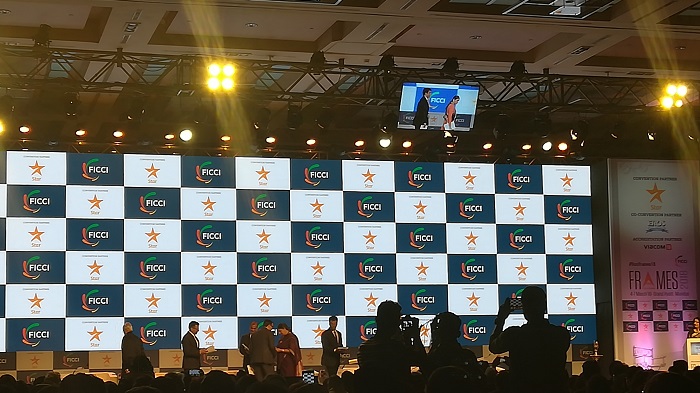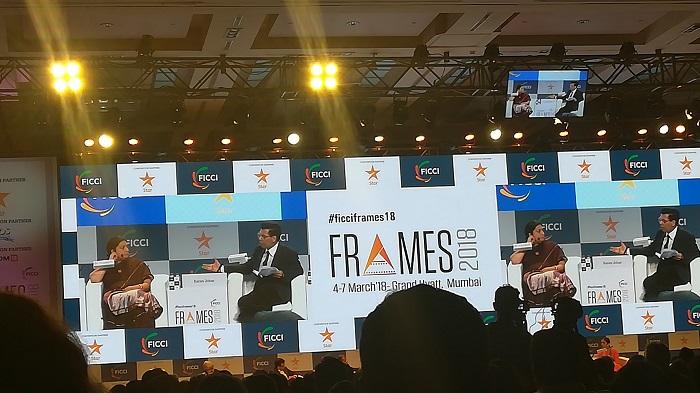The three-day global convention covering the entire gamut of media and entertainment industry, FICCI Frames, which begins tomorrow, saw its inauguration today at Grand Hyatt in Mumbai.
The inauguration began with a two-minute silence in the memory of late Indian actress Sridevi. This was followed by lamp lighting, by the dignitaries on the dias. Among these were FICCI president Rashesh Shah, union minister and ministry of information & broadcasting and textiles Smriti Zubin Irani, FICCI media & entertainment committee co-chair Siddharth Roy Kapur, Star India managing director Sanjay Gupta, FICCI secretary general Sanjaya Baru, FICCI FRAMES chief mentor Karan Johar and lyricist Prasoon Joshi.
FICCI president Rashesh Shah first took to stage for opening remarks, where he mentioned how the media and entertainment industry is growing by leaps and bounds with technological innovation being a part of that. “If business is the brain, then this industry is the heart of our country,” he said. “And FICCI is proud to bring both business and creative under one roof.”
Shah also revealed that FICCI will be launching its international content market which will run parallelly to the three-day conference. The setup will include buyer’s lounge, seller’s booth, Indian content showcase and many such events to bring buyers and sellers together. More than 2000 Indian delegates and about 600 foreign delegates are expected to be hosted for this market.

Post that, Sidddharth Roy Kapur took to stage. He posed the question: What do we not talk about? “What is the multiplier effect this (media and entertainment) industry has on the rest of the economy,” he began. “A 126000 crore is the gross output of this industry. A total of 200,000 crores in gross output is what the industry is able to stimulate in other industries by virtue of mutual existence. There are 7.4 lakh people employed, but indirectly, in the media and entertainment industry, there are 23.6 lakh people employed. Then there are hotels, transportation, gaming fashion and many other industries that we are able to impact by the mere potential of existence, but we don’t talk about enough.”
What then can we do as an industry? “We can focus on structure and formal trading for our technicians and creative people to be able to improve the quality of the content that we churn out. We can leverage data analytics so that better decisions can be made. We can move beyond the diaspora. Films like Secret Superstar shows our content is getting interesting. Films like Baahubali shows we haven’t even crossed over within our own country. To be able to put our content out there, we need to improve our windowing and ensure every platform is monetised enough to the best extent possible.”
He ended with a short story of 14 wolves who changed the ecosystem for good in the Yellow Stone national park, implying that even if the film industry of India is seen as wolves, these wolves are needed to bring about a good transformation in the ecosystem.
“These are truly exciting times for our industry. It is amongst the fastest growing sectors in the country and has crossed the Rs. 147 thousand crore mark,” started Star India managing director Sanjay Gupta. “What really motivates me to come to work every single day is the opportunity to play such a central role in the lives of a billion people. A billion people who look to watch an
exciting movie either in a theatre or on their tv screen or on a mobile phone, read the newspaper in their local language or listen to their favourite radio station – for information, for entertainment, and above all, for inspiration.”
We celebrate the art of storytelling, he continued. It is an art with the power to inspire change, to create aspirations, to make people believe in the possibilities and to spark imaginations. “And in my mind, there is no better time for us than now.”
He provided the statistics: “Digital is unleashing the power of new screens. Ours is a country
that has always been constrained by screens. There are only 9,000 theatres in the country. Then came television which over the last three decades has grown phenomenally. Today there are 16 crore TV screens and we add more than one crore new screens every year. But with the power of connectivity and low cost of data, in almost a click, over 35 crore more screens across the country have been lit up. With more and more affordable smartphones, we are adding more than one crore new smart screens every month. By the end of 2018, we would have added another 16 crore screens. This means that we will have 51 crore new screens on which us Indians will be engaging with all kinds of stories be it drama or sports, films or news. In a short period of 24 months, we have moved up from 16 crore TV screens and 9000 cinema halls to 67 crore screens. This is set to explode how we engage with stories – the time we spend, what we like, how deeply we follow them, and above all, how to have a two way conversation with both stories and storytellers.”
He posed the questions: “But are we setting our sights high enough? Are we really taking note of the opportunity in front of us? Are we looking to set the global standards for creativity and quality?”
Our ambition and the ambition of every stakeholder needs to change dramatically, he stated. “We have so much to offer to the world – our technological prowess, our creativity and the power of Indian stories. The time is now – to not only make in India but light up the world!”

FICCI-EY 2018 report titled Re-imagining India’s M&E Sector was then launched by the guests on the dias, who were joined by EY partner Ashish Pherwani and actress Huma Qureshi.
This was followed by a Q&A session with Smriti Irani, moderated by Indian film director and FICCI FRAMES chief mentor Karan Johar. “Multiplexes have shown limited growth and single screens have dropped in number. How do we strengthen exhibition of content to enhance numbers with cinema,” questioned Johar. Irani replied, “The answer lies in digital India; in personalising the experience for the viewer. We look at the expanse of the exhibition of the content through a perspective of say multiplex. But when we see it from a viewer’s point of view, it’s the affordability that’s the most talked about.”
Commenting on the advocacy of regional content, she said, “Another important aspect of our diversity that we can shout about from our rooftops is that few countries can boast regional films like we do. How many of them can really say that they have made a Marathi film or a Bengali one or even have a legend like Sridevi who’s done movies in five different languages? The more the expanse of content, the more the opportunities for local languages and talents to come to the fore.”

Johar asked, “Being an insider what needs to change?” Irani replied, “Film-makers need to talk more about domestic market potential and its numbers at every given opportunity. When we start enunciating about the economic values, will people realise the scale of the business.”
Concluding remarks were given by FICCI secretary general Sanjaya Baru. “Just as digital media is going to grow, just as entertainment media is going to grow, print media is also going to grow,” he said, coming from a print media background. “In 2018, our focus is on making Indian business go globally competitive, because it is about being able to do something in India, that can sell globally.”

